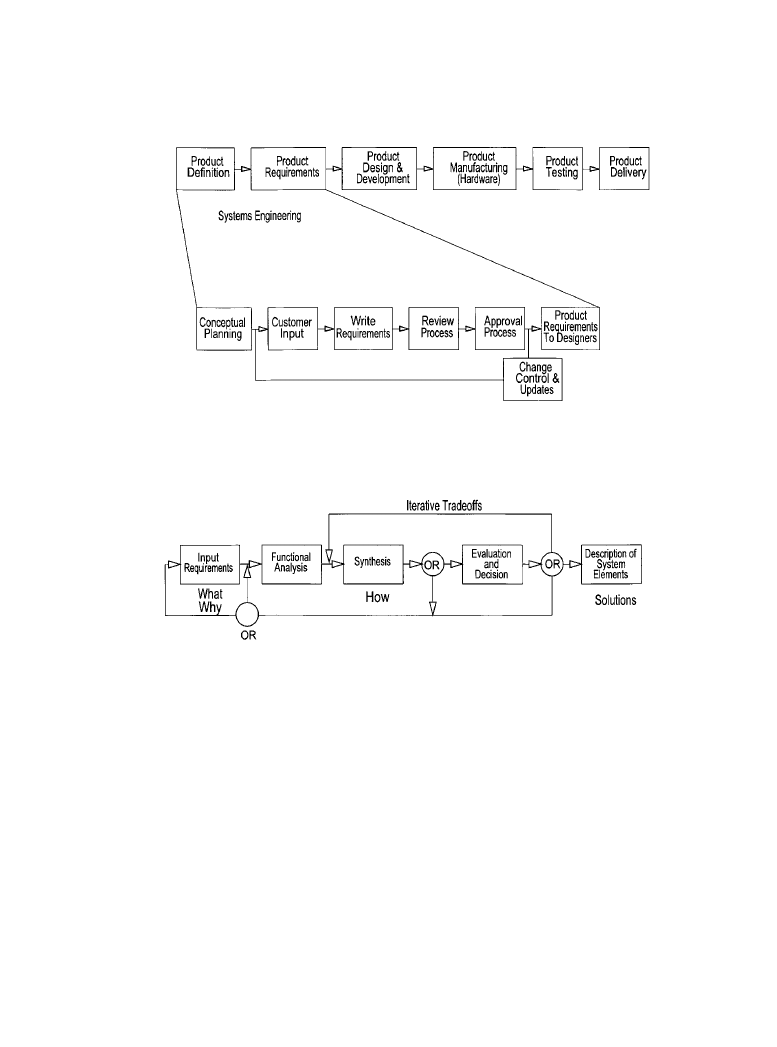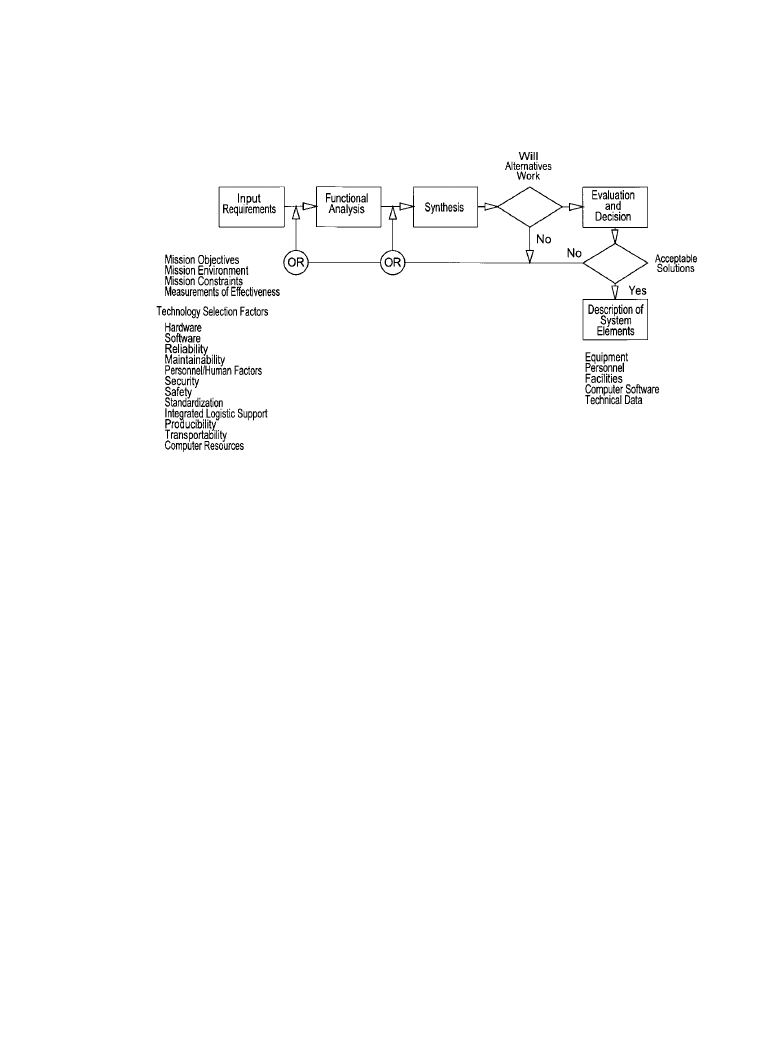ВУЗ: Казахская Национальная Академия Искусств им. Т. Жургенова
Категория: Книга
Дисциплина: Не указана
Добавлен: 03.02.2019
Просмотров: 21594
Скачиваний: 19

13-7
Chapter
13.1
Systems Engineering
Gene DeSantis
13.1.1 Introduction
Modern systems engineering emerged during World War II as—due to the degree of complexity
in design, development, and deployment—weapons evolved into weapon systems. In the sixties,
the complexities of the space program made a systems engineering approach to design and prob-
lem solving even more critical. Indeed, the Department of Defense and NASA are two of the
staunchest practitioners. With the increase in size and complexity of television and nonbroadcast
video systems during that same period, the need for a systems approach to planning, designing
and building facilities gained increased attention.
Today, large engineering organizations utilize a systems engineering process. Much has been
published about system engineering practices in the form of manuals, standards, specifications,
and instruction. In 1969, MIL-STD-499 was published to help government and contractor per-
sonnel involved in support of defense acquisition programs. In 1974, this standard was updated
to MIL-STD-499A, which specifies the application of system engineering principles to military
development programs. Likewise, the builders of turnkey television systems and facilities have
adopted their own unique systems engineering approaches to projects. The tools and techniques
of this processes continue to evolve in order to do each job a little better, save time, and cut costs.
13.1.2 Systems Theory
Although there are other areas of application outside of the broadcast industry, we will be con-
cerned with systems theory as it applies to television systems engineering. We will be concerned
with audio, video, RF, control, time code, telecommunications, computer systems, and software.
Systems theory can be applied to engineering of all of these elements. Building and vehicle sys-
tems—including space planning, power and lighting, environmental control, and safety sys-
tems—can all benefit from the systems engineering approach. These systems are made up of
component elements that are interconnected and programmed to function together in a facility.
For the purpose of this discussion, a system is defined as a set of related elements that func-
tion together as a single entity.
Systems theory consists of a body of concepts and methods that guide the description, analy-
sis, and design of complex entities.
Source: Standard Handbook of Audio and Radio Engineering
Downloaded from Digital Engineering Library @ McGraw-Hill (www.digitalengineeringlibrary.com)
Copyright © 2004 The McGraw-Hill Companies. All rights reserved.
Any use is subject to the Terms of Use as given at the website.

13-8 Standards and Practices
Decomposition is an essential tool of systems theory. The systems approach attempts to apply
an organized methodology to completing large complex projects by breaking them down into
simpler, more manageable components. These elements are treated separately, analyzed sepa-
rately, and designed separately. In the end, all of the components are recombined to build the
whole.
Holism is an element of systems theory in that the end product is greater than the sum of its
component elements. In systems theory, modeling and analytical methods enable all essential
effects and interactions within a system and those between a system and its surroundings to be
taken into account. Errors resulting from the idealization and approximation involved in treating
parts of a system in isolation, or reducing consideration to a single aspect, are thus avoided.
Another holistic aspect of system theory describes emergent properties. Properties that result
from the interaction of system components, properties that are not those of the components
themselves, are referred to as emergent properties.
Although dealing with concrete systems, abstraction is an important feature of systems mod-
els. Components are described in terms of their function rather than in terms of their form.
Graphical models such as block diagrams, flow diagrams, and timing diagrams are commonly
used.
Mathematical models may also be employed. Systems theory shows that, when modeled in
abstract formal language, apparently diverse kinds of systems show significant and useful iso-
morphisms of structure and function. Similar interconnection structures occur in different types
of systems. Equations that describe the behavior of electrical, thermal, fluid, and mechanical sys-
tems are essentially identical in form.
Isomorphism of structure and function implies isomorphism of behavior of a system. Differ-
ent types of systems exhibit similar dynamic behavior such as response to stimulation.
The concept of hard and soft systems appears in system theory. In hard systems, the compo-
nents and their interactions can be described by mathematical models. Soft systems can not be
described so easily. They are mostly human activity systems that imply unpredictable behavior
and non uniformity. They introduce difficulties and uncertainties of conceptualization, descrip-
tion, and measurement. The kinds of system concepts and methodology described previously can
not be applied.
13.1.2a
Systems Engineering
Systems engineering depends on the use of a process methodology based on systems theory. In
order to deal with the complexity of large projects, systems theory breaks down the process into
logical steps.
Even though underlying requirements differ from program to program, there is a consistent,
logical process that can best be used to accomplish system design tasks. The basic product devel-
opment process is illustrated in Figure 13.1.1. The systems engineering starts at the beginning of
this process to describe the product to be designed. It includes four activities:
•
Functional analysis
•
Synthesis
•
Evaluation and decision
•
Description of system elements
Downloaded from Digital Engineering Library @ McGraw-Hill (www.digitalengineeringlibrary.com)
Copyright © 2004 The McGraw-Hill Companies. All rights reserved.
Any use is subject to the Terms of Use as given at the website.
Systems Engineering

Systems Engineering 13-9
This process is illustrated in Figure 13.1.2. The process is iterative. That is, with each succes-
sive pass, the product element description becomes more detailed. At each stage in the process a
decision is made whether to accept, make changes, or return to an earlier stage of the process and
produce new documentation. The result of this activity is documentation that fully describes all
system elements and which can be used to develop and produce the elements of the system. The
systems engineering process does not produce the actual system itself.
13.1.2b
Functional Analysis
A systematic approach to systems engineering will include elements of systems theory. (See Fig-
ure 13.1.3.) To design a product, hardware and software engineers need to develop a vision of the
Figure 13.1.1
The product development and documentation process.
Figure 13.1.2
The systems engineering process. (
After [1].)
Downloaded from Digital Engineering Library @ McGraw-Hill (www.digitalengineeringlibrary.com)
Copyright © 2004 The McGraw-Hill Companies. All rights reserved.
Any use is subject to the Terms of Use as given at the website.
Systems Engineering

13-10 Standards and Practices
product—the product requirements. These requirements are usually based on customer needs
researched by a marketing department. An organized process to identify and validate customer
needs will help minimize false starts. System objectives are first defined. This may take the form
of a mission statement that outlines the objectives, the constraints, the mission environment, and
the means of measuring mission effectiveness.
The purpose of the system is defined, analysis is carried out to identify the requirements and
what essential functions the system must perform, and why. The functional flow block diagram is
a basic tool used to identify functional needs. It shows logical sequences and relationships of
operational and support functions at the system level. Other functions such as maintenance, test-
ing, logistics support, and productivity may also be required in the functional analysis. The func-
tional requirements will be used during the synthesis phase to show the allocation of the
functional performance requirements to individual system elements or groups of elements. Fol-
lowing evaluation and decision, the functional requirements provide the functionally oriented
data required in the description of the system elements.
Analysis of time critical functions is also a part of this functional analysis process when func-
tions have to take place sequentially, or concurrently, or on a particular schedule. Time line doc-
uments are used to support the development of requirements for the operation, testing, and
maintenance functions.
Figure 13.1.3
The systems engineering decision process. (
After [1].)
Downloaded from Digital Engineering Library @ McGraw-Hill (www.digitalengineeringlibrary.com)
Copyright © 2004 The McGraw-Hill Companies. All rights reserved.
Any use is subject to the Terms of Use as given at the website.
Systems Engineering

Systems Engineering 13-11
13.1.2c
Synthesis
Synthesis is the process by which concepts are developed to accomplish the functional require-
ments of a system. Performance requirements and constraints, as defined by the functional anal-
ysis, are applied to each individual element of the system, and a design approach is proposed for
meeting the requirements. Conceptual schematic arrangements of system elements are devel-
oped to meet system requirements. These documents can be used to develop a description of the
system elements and can be used during the acquisition phase.
13.1.2d Modeling
The concept of modeling is the starting point of synthesis. Because we must be able to weigh the
effects of different design decisions in order to make choices between alternative concepts, mod-
eling requires the determination of those quantitative features that describe the operation of the
system. We would, of course, like a model with as much detail as possible describing the system.
Reality and time constraints, however, dictate that the simplest possible model be selected in
order to improve our chances of design success. The model itself is always a compromise. The
model is restricted to those aspects that are important in the evaluation of system operation. A
model might start off as a simple block diagram with more detail being added as the need
becomes apparent.
13.1.2e
Dynamics
Most system problems are dynamic in nature. The signals change over time and the components
determine the dynamic response of the system. The system behavior depends on the signals at a
given instant, as well as on the rates of change of the signals and their past values. The term “sig-
nals” can be replaced by substituting human factors, such as the number of users on a computer
network for example.
13.1.2f
Optimization
The last concept of synthesis is optimization. Every design project involves making a series of
compromises and choices based on relative weighting of the merit of important aspects. The best
candidate among several alternatives is selected. Decisions are often subjective when it comes to
deciding the importance of various features.
13.1.2g
Evaluation and Decision
Program costs are determined by the tradeoffs between operational requirements and engineering
design. Throughout the design and development phase, decisions must be made based on evalua-
tion of alternatives and their effects on cost. One approach attempts to correlate the characteris-
tics of alternative solutions to the requirements and constraints that make up the selection criteria
for a particular element. The rationale for alternative choices in the decision process are docu-
mented for review. Mathematical models or computer simulations can be employed to aid in this
evaluation decision making process.
Downloaded from Digital Engineering Library @ McGraw-Hill (www.digitalengineeringlibrary.com)
Copyright © 2004 The McGraw-Hill Companies. All rights reserved.
Any use is subject to the Terms of Use as given at the website.
Systems Engineering